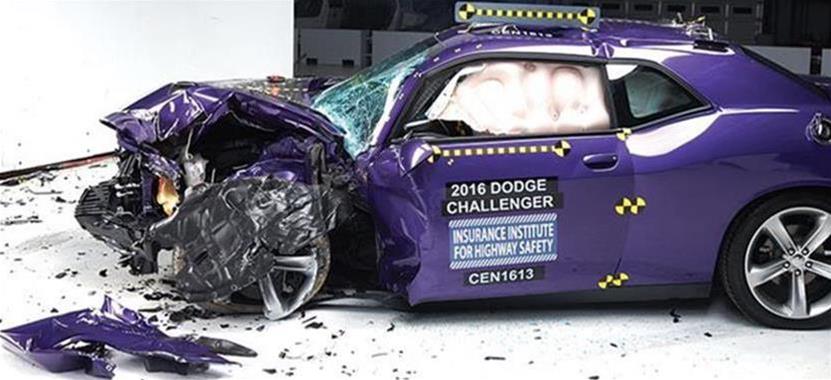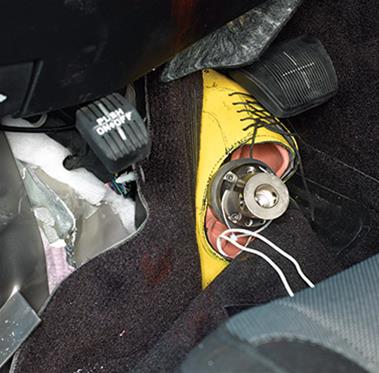From the Insurance Institute for Highway Safety. Their crash tests are more stringent than the federal "five-star" tests.
Muscle cars fall short of safety awards


Muscle cars fall short of safety awards
Status Report, Vol. 51, No. 5 | May 24, 2016 Subscribe
Flexing muscleSports car ratings show range of performance
Think "muscle car" performance, and images of speed and power are more likely to come to mind than crash tests and safety ratings. Because no one buys a sports car to drive in the slow lane, the best all-around occupant crash protection is crucial. IIHS recently put a trio of iconic sports coupes through their paces, and unlike more sedate sedans, none earns the scores needed to clinch a Top Safety Pick award.
IIHS evaluated 2016 models of the Chevrolet Camaro, Dodge Challenger and Ford Mustang in the full battery of crashworthiness evaluations. The Mustang comes closest to earning Top Safety Pick, while the Camaro falls short in one category and lacks an available front crash prevention system. The Challenger is most in need of improvement.
To qualify for Top Safety Pick, vehicles must earn good ratings in the small overlap front, moderate overlap front, side, roof strength and head restraint evaluations and have a basic-rated front crash prevention system. To qualify for the Institute's highest award, Top Safety Pick+, vehicles must earn good ratings in the five crashworthiness tests and an advanced or superior rating for front crash prevention.
IIHS doesn't typically crash-test sports cars as they make up a small share of the consumer market. IIHS engineers decided to evaluate these models with optional V-8 engines because they are big sellers in their class, and consumers often ask how they would perform in crash tests.
Insurance data point to high losses for sports cars. As a group, they have the highest losses among passenger vehicles for crash damage repairs under collision coverage, data from the Highway Loss Data Institute show. Collision coverage insures against physical damage to the at-fault policyholder's vehicle in a crash.
"Given that sports cars have high crash rates, it's especially important that they offer the best occupant protection possible in a crash," says Adrian Lund, IIHS president.
The Camaro, Challenger and Mustang earn good ratings for occupant protection in a moderate overlap front crash, as well as a side impact.
In the newest and toughest IIHS crashworthiness evaluation, the small overlap front test, the Camaro earns a good rating, the Mustang earns acceptable, and the Challenger is rated marginal.
"The Mustang is just one good rating away from earning Top Safety Pick," Lund points out. "Its small overlap rating holds it back."
Added in 2012, the small overlap test replicates what happens when a vehicle runs off the road and hits a tree or pole or clips another vehicle that has crossed the center line. In the test, 25 percent of the total width of the vehicle strikes the 5-foot-tall rigid barrier on the driver side at 40 mph. It is an especially challenging test because it involves a vehicle's outer edges, which aren't well-protected by the crush-zone structures. Crash forces go directly into the front wheel, suspension system and firewall.
The Challenger wasn't up to the challenge of the small overlap test. Extensive intrusion into the lower occupant compartment limited the driver's survival space and resulted in a poor rating for structure and for leg/foot protection. Measures taken from the dummy indicate a high likelihood of serious lower leg injuries.
"During the crash, the Challenger's front wheel was forced rearward into the occupant compartment, and the footwell intrusion trapped the dummy's left foot and deformed its ankle," Lund explains. "Our technicians had to unbolt the dummy's foot from its leg in order to free it. Entrapment is pretty rare. That's only happened five other times in a small overlap test."
In contrast, survival space for the driver in the Camaro was well-maintained, and the risk of injuries to the dummy's legs and feet was low. The Camaro was redesigned for the 2016 model year.
"The Camaro's safety cage is built to resist intrusion in a small overlap crash, and that's good news for Camaro drivers," Lund says.
The Mustang's structural performance in the small overlap test fell short of the Camaro's but was an improvement over the Challenger. The roof buckled, and the driver's survival space was compromised by considerable intrusion of the door hinge pillar and instrument panel. Still, measures taken from the dummy indicated low risk of injuries to all body regions, including the legs and feet.
The Camaro and Mustang earn good ratings for head restraints and seats to protect against neck injuries in rear crashes. The Challenger's head restraints are rated acceptable.
The Mustang earns a good rating for roof strength, and the Camaro and Challenger earn acceptable. Stronger roofs crush less in rollovers, reducing the risk that people will be injured by contact with the roof itself and the risk that unbelted occupants will be ejected. Strong roofs are especially important for sports cars, which have among the highest driver death rates in single-vehicle rollovers (see "Saving lives: Improved vehicle designs bring down death rates," Jan. 29, 2015).
Ford and Dodge offer optional forward collision warning systems on the Mustang and Challenger, and both coupes earn a basic rating for front crash prevention because their systems meet performance criteria set by the National Highway Traffic Safety Administration.


The Dodge Challenger struggled in the small overlap test. Extensive occupant compartment intrusion limited survival space for the driver.
The footwell deformed around the dummy's left foot, and technicians had to unbolt the dummy's leg to free it from the wreckage.



